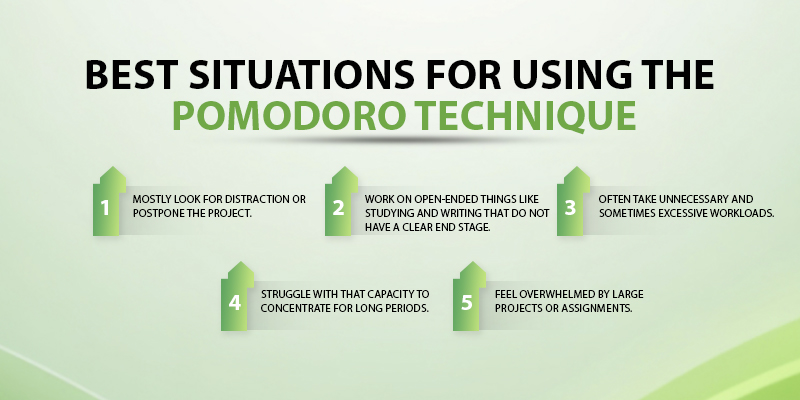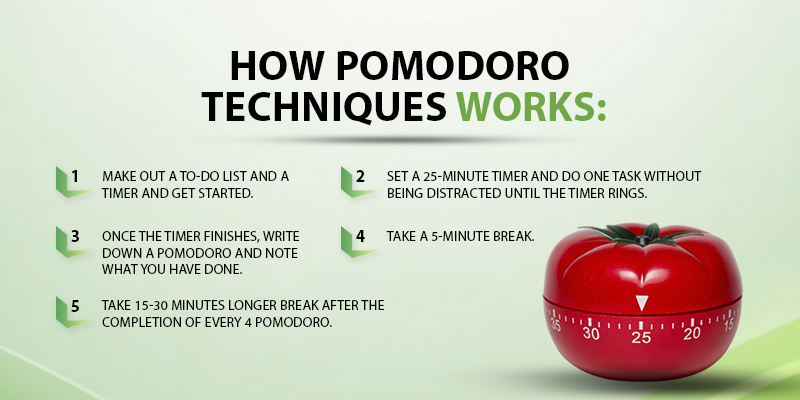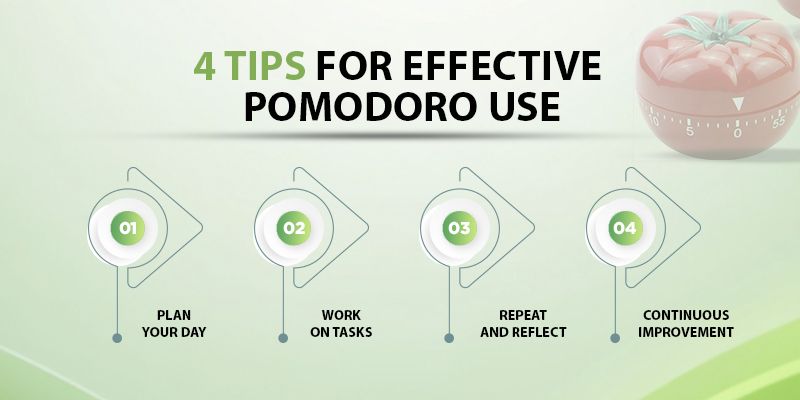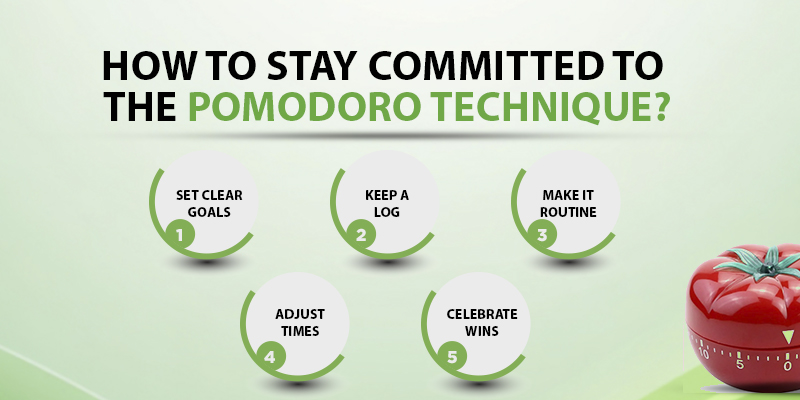The great technique to manage the time is exactly to break the hours into tomatoes. It sounds funny initially, but millions of people around claim that this technique is the way of life. (Pomodoro is an Italian word that means tomato.)
This time management technique requires you to divide your work into pomodoros (focused work sessions) and then take short breaks regularly to be able to keep your concentration and prevent sudden mental fatigue.
It is a small yet effective strategy that improves your productivity. It divides your workday into several segments of focused work and short breaks of rest. If you face delaying work or you feel overwhelmed with all the things on your to-do list, then this guide would be really helpful for you.
You Will Learn
ToggleThe Beginning
It is a time management technique that was invented by Francesco Cirillo a university student in 1980s, who was facing difficulties in focusing on his studies.
Feeling like he was overwhelmed, he decided to break down his study time into short focused periods using a kitchen timer with a tomato shape. This is how he named it the Pomodoro Technique after the Italian word for tomato.
Encouraged by the challenge of working in such a short burst, Cirillo learned a way that kept him focused and helped him be productive, ultimately leading to the development of the Pomodoro Technique
Increase your business productivity with WorkStaff360’s exceptional services! Discover how our virtual assistant solutions can streamline your operations, boost efficiency, and free up your time to focus on what truly matters. Don’t let tasks hold you back.
Best Situations for Using the Pomodoro Technique

You need to adopt this time managing technique if you:
- Mostly look for distraction or postpone the project.
- Work on open-ended things like studying and writing that do not have a clear end stage.
- Often take unnecessary and sometimes excessive workloads.
- Struggle with that capacity to concentrate for long periods.
- Feel overwhelmed by large projects or assignments.
What is the Pomodoro Technique?

In this technique, you can use 25-minute work periods, known as “Pomodoro”, which also include short breaks. Here’s how it works:
- Make out a to-do list and a timer and get started.
- Set a 25-minute timer and do one task without being distracted until the timer rings.
- Once the timer finishes, write down a Pomodoro and note what you have done.
- Take a 5-minute break.
- Take a 15-30 minutes longer break after the completion of every 4 Pomodoro.
As you delve into the Pomodoro Technique, don’t overlook another effective time management technique: Timeboxing. Learn how to allocate specific time blocks to tasks and supercharge your productivity. Check out our latest blog post for all the details!
The Pomodoro Technique follows these simple rules:
Work with Time, Not Against It: Create work chunks of 25 minutes that the timer will control to create a focus and productivity mode within the fixed interval. Feeling the urgency of the given deadlines, you will maximize the efficiency of your work.
Eliminate Burnout: Taking breaks regularly to remain energized and avoid fatigue will ensure the persistence of the productivity level throughout the day. Take time to relax during every break to help maintain your mental strength and working ability.
Manage Distractions: Note the distractions and put them aside, or address them during the break times, thus developing deeper focus and better control over the disturbances. Make strategies to lessen distractions and maintain focus during work sessions. concentration during work sessions.
Break Down Complex Projects: Break down the large tasks into smaller activities which would be easier to organize and start moving little by little. Breaking down complex objectives makes it easier to understand and to ensure that every task is well performed.
Group Small Tasks: Combine short activities and execute them at one time to maximize time and eliminate the transition periods. Teamwork and consolidation of responsibilities enhance the effectiveness of executing the workflow and also provide opportunities for high productivity.
Respect the Pomodoro: Make Pomodoros uninterruptible and treat every session as a concentrated period of work. Use the Sand timer to the fullest to optimize productivity and fully to the task at hand.
What makes the Pomodoro Technique so effective? Making it easy to get started
The Pomodoro technique helps you manage big tasks in smaller 25-minute time intervals. With this, you will not feel like struggling with the whole project at once, but you will just do what is necessary for the next 25 minutes, a much less discouraging prospect.
Combating Distractions
For every Pomodoro, you should avoid all distractions and devote all your undistracted attention to the task. Thus, your brain learns to concentrate and stop yourself from self-interruptions that can distract you.
Becoming More Aware Of Time
By breaking the work into small time-bound periods, you start learning the actual time task needs to be completed. This will allow you to plan out your days more clearly and lead to developing a solid time management system.
Gamifying Productivity
The Pomodoro Technique involves always working within the set number of Pomodoro periods as the more Pomodoros you complete, the more you can gamify and add a fun element to your work routine. Through this approach, you will find it easier to drive motivation and build up pace.
4 Tips for Effective Pomodoro Use

By integrating the Pomodoro technique with Todoist(daily routine-based work) you can get high productivity levels and the best task management. Below are detailed steps and examples for each stage of the process:
1-Plan Your Day
Activity: Begin your day by looking at your Todoist where your projects and tasks are identified. Choose things that you want to complete today.
Detail: Plan how many Pomodoros of 25 minutes you need for each task. Similarly, if a task is due and you think it would take approximately 2 hours, four Pomodoros should be set for it. Mark your time estimates next to each task in Todoist by putting a tomato emoji next to a job.
Example: The student’s first task is to produce the presentation. After reviewing the content, you figure it will take you three Pomodoros to finish the task. In Todoist, you prioritize your task for that day and indicate the completion of it with three emojis of tomatoes.
2-Work on Tasks
Activity: Use a Pomodoro timer or Pomodone app as a time management tool. Set the time for (Pomodoro 25 minutes) and concentrate on what is in front of you.
Detail: When it comes to each work session, if you happen to think of something else that needs to be done or if an idea flashes in your mind, avoid switching tasks. Other than that, move them directly to the Inbox of your Todoist to get back to your Pomodoro technique.
Example: Meanwhile, your fellow is waiting for your feedback. You recall that you need to email this fellow of yours. Instead of working on it right away, you just put it in your Inbox and continue with the presentation until the Pomodoro is done.
3-Repeat and Reflect
Activity: Do your Pomodoro planning daily. Set a regular task in Todoist to remind you to plan your day in the morning.
Detail: In the end, count the number of Pomodoros you completed and think about what you should change to make the technique more effective.
Example: To be more specific if you set yourself a challenge to do 12 pomodoros every day. By the end of the day don’t forget to check if you accomplished that. If you had only accomplished 10, think about why – was there any distraction or did it take more time than expected? Adjust your planning accordingly.
4-Continuous Improvement
Activity: Set up a goal to do a couple of Pomodoro more each day than the previous day and observe this with the help of a Todoist.
Detail: Every week, review your productivity trends and find those patterns that repeat or those tasks that take longer or shorter than expected.
Example: While at the end of a week, you may discover that the administration-related activities take fewer Pomodoros than planned, tasks like writing or design may occupy more time. Apply this finding to improve your task scheduling and forecasting for future projects.
Using these steps in a disciplined way and the combination of the Pomodoro Technique with Todoist, you can gain effectiveness. Also, you can shut out distractions, and get more work done in a timely and organized manner.
Pomodoro Tools and Apps
Several such tools are available to you, ranging from simple timers to comprehensive apps, which integrate with task management systems.
Here are some popular options:
- Pomodoro Timer: A regular kitchen timer will do the job, but you might find a digital timer more convenient. The most important thing, it should be able to count 25 minutes.
- Pomodoro Apps: Various Pomodoro Technique apps are developed especially. Popular ones include:
- TomatoTimer: A user-friendly and web-based Pomodoro timer that can be accessed online from any device.
- Focus Booster: This app not only tracks the Pomodoros but also gives information on your productivity behavior.
- Pomodone: It integrates with the main task management apps, such as Trello, Asana, or Todoist as well as you can plan to have Pomodoro sessions in your already existent task lists.
- Browser Extensions: Tools like Marinara: Pomodoro® Assistant for Chrome can help you to use your Pomodoros in a web browser without adding additional software.
- Physical Timers: Others like a small and portable device that is shaped like the traditional kitchen timer which often comes in the form of a tomato, further aiding the other features of the Pomodoro technique.
- Smartphone Apps: Many applications are available for both Android and iOS platforms, eg Forest which uses game elements to make the process of focusing enjoyable by growing a tree every Pomodoro session.
How to Stay Committed to the Pomodoro Technique?

Consistency is key.
- Set Clear Goals: Decide as to what you want to get out of the technique like becoming a finisher or good at focus.
- Keep a Log: Track the number of Pomodoros you are excepting to make each day to see your progress.
- Make It Routine: Schedule Pomodoro sessions for your everyday workflow similar to regular breaks.
- Adjust Times: Modify the timing of Pomodoros and break time according to your working routine.
- Celebrate Wins: Take the lead in rewarding yourself with successfully ticking off your Pomodori goals, be it on a daily or weekly basis.
This simple approach can be implemented into your daily routine and you’ll find it useful and pleasurable if you follow it.
Conclusion
To summarize, the Pomodoro technique is an effective technique to stick to things and do them according to time.
Set a timer for 25 minutes dedicating your attention to only one task uninterruptedly, and then having a five-minute break helps to prevent procrastination and maintain good performance.
This sequential approach breaks complex work into manageable parts that ultimately ensure focused attention to detail and also the successful completion of tasks. It helps you get things done without interruption.
FAQs
What should you do in case you start breaking away?
Make use of breaks to stretch, grab a coffee, or take some time off the screen.
How many Pomodoros should be the daily goal?
Set the daily goal at 16 Pomodoro intervals, which totals up to about 8 hours with breaks.
Is the Pomodoro Technique for Everyone?
It’s a good fit for people who like schedule-based work, but maybe is not a good fit for every person.
Can the Pomodoro Technique Be a Powerful Tool Against Procrastination?
Yes, it highly makes tasks less complicated into small segments making it not so difficult and you forget to procrastinate the work.
Is the Pomodoro Technique Effective for Teamwork on Projects?
Yes, it streamlines the work process and rest time and makes staff collaboration more effective while mitigating the meeting fatigue.











